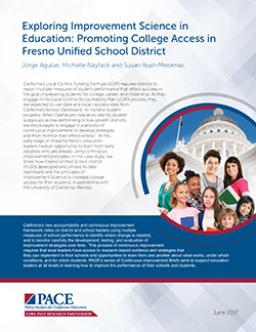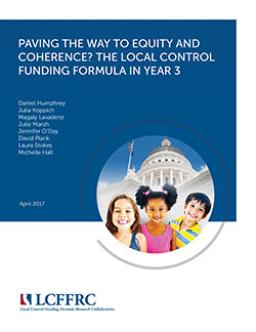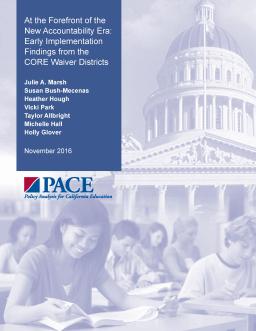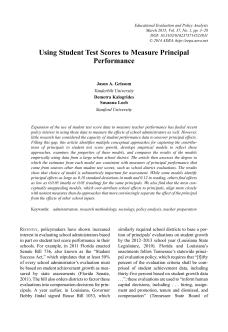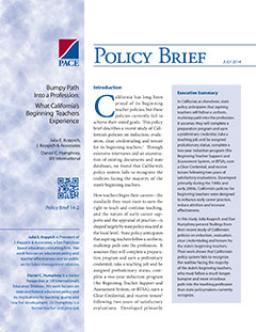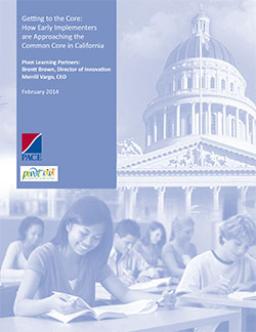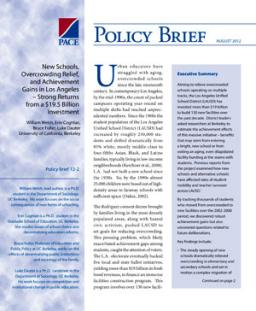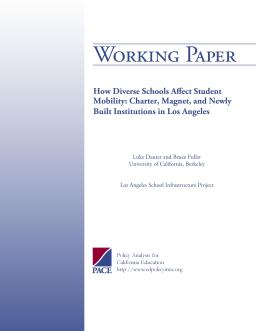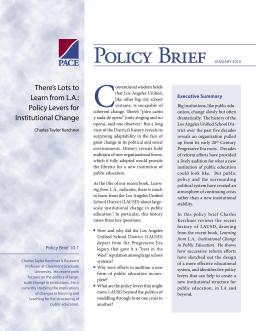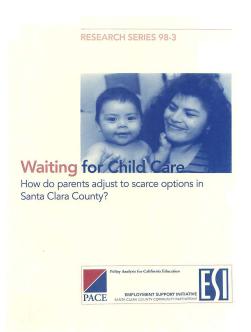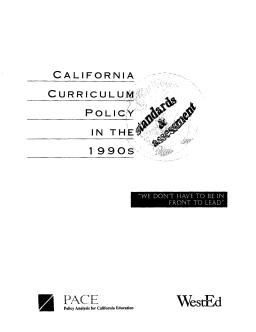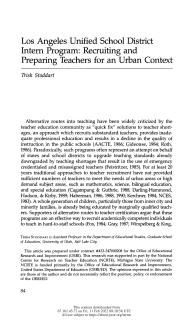Promoting College Access in Fresno Unified School District
Published
Summary
California's Local Control Funding Formula (LCFF) requires districts to report student performance measures and use state and local data to monitor progress towards preparing students for college, career, and citizenship. Fresno Unified School District (FUSD) utilized principles of Improvement Science and a data dashboard to increase college access for students, in partnership with the University of California, Merced.
The Local Control Funding Formula in Year 3
Published
Summary
The Local Control Funding Formula (LCFF) gives districts funding authority and requires input from stakeholders to create Local Control Accountability Plans (LCAPs) for equitable resource allocation and improved student outcomes. This report explores stakeholder engagement, implementation challenges, resource allocation, and equity using eight case studies. Despite limitations, this study offers valuable insights into California's K-12 education system's finance and governance.
Early Implementation Findings from the CORE Waiver Districts
Published
Summary
The Local Control and Accountability Plan (LCAP) in California and the federal Every Student Succeeds Act (ESSA) encourage local control in school accountability. The CORE waiver districts have implemented an innovative measurement system and supports for school and district improvement, providing an opportunity to learn from the enactment of a system supported by accountability policy in this new era. This report examines the early implementation and effects of the CORE reform and seeks to inform the ongoing efforts within CORE and future accountability policy in other states and districts.
Learning from the CORE Districts' Focus on Measurement, Capacity Building, and Shared Accountability
Published
Summary
California and the US are undergoing a cultural shift in school accountability policies towards locally-determined measures of school performance. Lessons can be learned from the CORE districts, which developed an innovative accountability system, emphasizing support over sanctions, and utilizing multiple measures of school quality. The CORE districts' measurement system and collaboration hold promise for improving local systems, but efforts to build capacity remain a work in progress.
Published
Summary
This article examines the use of student test score data to measure the effects of school principals on student achievement. Multiple models are developed and compared using data from a large urban school district, with results showing the importance of model choice for accurately assessing principal effects. The most conceptually unappealing models that over-attribute school effects to principals align more closely with nontest measures than do approaches that more convincingly separate the effect of the principal from the effects of other school inputs.
What California's Beginning Teachers Experience
Published
Summary
California's policies for beginning teachers assume a uniform path of completing a preparation program, BTSA, earning a Clear Credential and tenure. However, a recent study shows that the policies fail to recognize the reality of a longer, bumpier and more circuitous path faced by the majority of beginning teachers.
How Early Implementers are Approaching the Common Core in California
Published
Summary
California has adopted new Common Core State Standards (CCSS), English Language Development (ELD) standards, and Next Generation Science Standards (NGSS). The state has provided funding to support CCSS implementation, and new curriculum frameworks are nearing completion. The report focuses on early implementers of CCSS to identify lessons learned and potential pitfalls, aiming to inform practitioners and policymakers about the variety of CCSS implementation strategies California school districts are choosing.
Strong Returns from a $19.5 Billion Investment
Published
Summary
The LAUSD invested over $19B to build 130 new facilities to relieve overcrowded schools. A PACE policy brief analyzed its effects on student achievement and found robust gains for many elementary-school pupils who switched from old to new facilities. However, significant gains were limited to elementary school students and new high school facilities produced weak and inconsistent achievement gains. The report also tracked thousands of students who moved from overcrowded to new facilities over the 2002-2008 period.
Chaffey College’s Long Journey to Success
Published
Summary
Chaffey College in California's Inland Empire is renowned for its "risk tolerant change-oriented culture" and impressive student support programs, which have led to exceptional outcomes for Chaffey students. In this working paper, researchers visited Chaffey and other California colleges to examine the quality of instruction in basic skills and the integration of student support services. Chaffey's success story highlights the importance of developing a broad structure necessary for success both in developmental education and for all students.
Charter, Magnet, and Newly Built Campuses in Los Angeles
Published
Summary
This paper examines the impact of pupil mobility in urban districts like Los Angeles, where families are encouraged to switch schools due to the growth of mixed-markets of charter, magnet, and pilot schools. African American and White students are more likely to exit their schools, while overcrowding in low-income Latino neighborhoods leads to higher exit rates. Charter and magnet school students exit less. The district's commitment to relieve overcrowding leads to Latino students moving to newly built schools. The opening of new high schools reduced pupil mobility.
Framing the Issues in Community Colleges
Published
Summary
This paper series addresses the issue of basic skills instruction in California Community Colleges. The problem is twofold: a high proportion of students enter college needing developmental courses, and these students are unlikely to move into college-level work. The research focuses on instructional issues, with observations and interviews to understand classroom and institutional settings. The subsequent papers in the series will cover various hypotheses for why success rates in basic skill instruction are not higher.
California’s Quality Education Investment Act
Published
Summary
This working paper examines the use of Quality Education Investment Act (QEIA) funds, which allocated $2.6B over seven years to California's lowest-performing schools. The authors conducted a study of four Los Angeles high schools to investigate how QEIA dollars were spent in the first year, who made the decisions, and how funds were used to improve teaching and the instructional program. The study found that district officials and principals had discretion in allocating funds, consistent with recent efforts to deregulate categorical-aid programs and give local educators fiscal discretion.
Policy Levers for Institutional Change
Published
Summary
The Los Angeles Unified School District has undergone decades of reform, resulting in an unstable atmosphere rather than institutional stability. A recent book, "Learning from L.A.: Institutional Change in Public Education," identifies five policy levers that can create a more effective educational system and a new institutional structure for public education, both in LA and beyond.
A Study of Eight States and the District of Columbia
Published
Summary
This report presents the results of a study investigating the impact of charter schools on school districts, how they responded, and whether they experienced systemic change due to charter laws. The study focused on eight US states and the District of Columbia and included case studies of 25 affected school districts. The research was funded by The Saint Paul Foundation and conducted in 1997, six years into the charter school experiment. PACE hosted the study.
How Do Parents Adjust to Scarce Options in Santa Clara County?
Published
Summary
In 1998, the PACE research center surveyed low-income and blue-collar parents to help streamline the process of finding childcare, in response to the state's welfare reform legislation. The survey included 300 in-depth interviews and covered topics such as employment, searching for childcare, interim childcare, and perceptions of care quality. The report addresses the policy problem and how parents perceive their limited childcare options.
Standards and Assessments
Published
Summary
This study traces California's curriculum-related reforms in mathematics and science during the 1990s, examining the role of the California Department of Education and the state's shifting political and policy context. It analyzes the perceptions of state officials, experts, and the public and how they influenced state policy changes. The authors raise questions about problems associated with curriculum policy in California and presents policy recommendations mentioned during interviews and document analysis. The study does not assess the impact of curriculum on school practice.
Published
Summary
The research base for understanding and prescribing policy for school boards is limited due to the large number of boards and members. Common school boards, especially those of small districts, are less researched. To address this, overall trends affecting most boards should be analyzed to determine the need for and direction of school board reform. Waiting for representative data on all boards will delay improvements to policy making. Major changes in school board roles, functions, and operations are necessary due to the interaction of these trends.
Recruiting and Preparing Teachers for an Urban Context
Published
Summary
Traditional teacher recruitment fails to meet urban area and high-demand subject needs. Alternative certification programs offer a solution but are criticized for being a "quick fix". The LAUSD Intern Program case study addresses questions on effectiveness and preparation of alternative-certified teachers. On-the-job training is context-specific and not a replacement for college-based education.
Recruiting and Preparing Teachers for an Urban Context
Published
Summary
This article discusses the criticism of alternative routes to teaching, which are seen as inadequate and leading to declining instructional quality, but are attempting to address the shortage of qualified teachers in urban and high demand subject areas. Supporters argue that they are effective in recruiting competent teachers for hard-to-staff schools and replacing the emergency credential system with rigorous training. The article highlights the impact of teacher shortages on inner city and minority students who are currently being educated by marginally qualified teachers.
